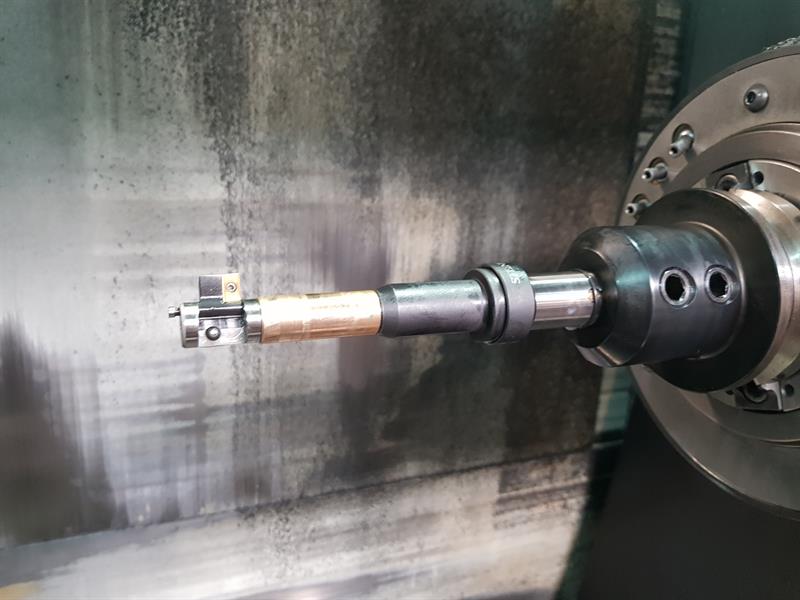Lunn Engineering Co has been able to introduce a fully automatic production cycle, significantly reducing production lead time and operational routines when machining cast iron flywheel housings for off-road vehicles, following application of the Steiner Autofacer back counterboring tool.
Previously, due to the difficulty to access and the design restraints of some of the features to be machined, a separate counterboring operation had to be set up in an adjacent machining bay that not only added logistical problems and additional work handling but also significantly extended lead times to complete the parts. Previous attempts to use a back counterboring tool had failed.
Says Lunn Engineering works foremen Martin Sharpe: “We have produced some 1,400 of these components on our horizontal, twin-pallet machining centre, which was installed specifically to machine these castings. However, we have always had to run an additional operation on a horizontal borer located in another bay, just to produce three counterbore features that were very difficult to access as they were set back behind the main location flange of the housing.”
Sharpe says that the effect of combining operations from three into two has been relatively marginal on overall cycle time but most important, it has enabled a fully automatic production cycle involving A and B fixtures on the twin-pallet machine that has considerably reduced lead times, work handling, setting, operator attention and inspection times. As a result of the change, Lunn Engineering has also been able to concentrate production and sub-assembly of the flywheel housing in one area of the works.
Other gains are improved control over quality by eliminating a third relocation of the workpiece, plus tool life increased to achieve some 120 counterbores per insert corner. This is largely due to the combination of the inherent rigidity of the machining centre and the Autofacer tool set-up, as opposed to the previous method involving varying tool life and the workholding arrangement of the borer. The two operations on the machining centre now incorporate milling, boring, drilling, counterboring and tapping sequences.
Lunn Engineering produces two types of housing for two- and four-wheel drive off-road vehicles at a rate of 15 per week. Following machining, the housings are cleaned, painted and then sub-assembled for the customer, including insertion of bearings.
Following the success of the application engineering and trials of the Mollart supplied Autofacer, the engineering team is now working on further process improvements to replace twist drills used on specific deep holes in the two housing types with Botek gundrills. This will provide improved efficiently to produce certain special holes within +/- 0.2 mm geometrical tolerances.
Box item
Process detail
Access to produce the three counterbores is severely restricted such that the only way it could be achieved was by back counterboring through three 18 mm diameter holes. These holes are drilled through from the outer face of the housing directly opposite the main flange face that is used for initial first operation location on the fixture. It was this main flange that partially covered each counterbore position that is set back inside the well of the housing.
Adding to the problems was a steep draft angle around each of the three features that meant any back counterboring tool had to cope with progressive material build-up creating a variable interrupted cut. Indeed, it was this draft angle that aided the failure of previous attempts to back counterbore using competitor tooling resulting in chatter and inconsistent tool life.
According to Sharpe, following the visit and assessment by Mollart’s tooling engineer, it was recommended that the Steiner Autofacer tool was employed because of its high rigidity and being well-proven in applications of this type. Both Sharpe and the engineer then worked together to develop the process and set the speeds and feed rates whereby the spindle is now run at 810 rpm with a feed rate of 0.04 mm/rev.
The Steiner ‘Bump-Style’ Autofacer spotface/counterbore tool is activated from contact with the datum face of the workpiece as it passes through the previously drilled 18 mm holes. Each drilled hole is used to support a pilot bearing on the Autofacer tool, which is positioned behind the insert pocket on the body of the tool. By reversing the machine spindle, an internal friction clutch mechanically opens and locks the cutter blade to the set dimension of 36 mm diameter.

The Steiner Autofacer back counterboring tool has succeeded where other styles failed
The tool is then fed in reverse back into the casting and when a programmed depth of 32.5 +/- 0.05 mm is reached from the machined datum face, the tool is fed back and a cone positively drives the cutter blade to its closed position into the tool head before it is automatically withdrawn back down the 18 mm pilot hole. It now takes just 6 mins 20 secs to complete the three holes.
Said Mr Lunn: “We had such a recent success producing a one-off bespoke gold-plated desk fitted with an Onyx top for one of our customers, a leading UK aircraft interior specialist.We were then asked to make a smaller version to accommodate a printer.”



